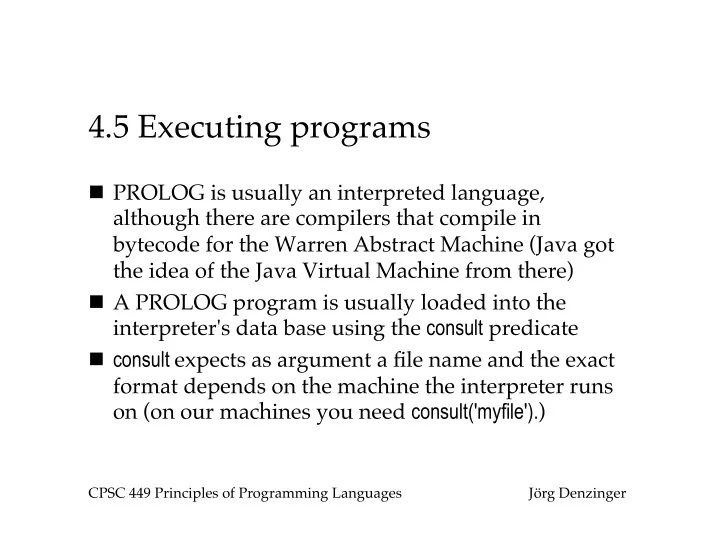

4.5 Executing programs � n PROLOG is usually an interpreted language, although there are compilers that compile in bytecode for the Warren Abstract Machine (Java got the idea of the Java Virtual Machine from there) � n A PROLOG program is usually loaded into the interpreter's data base using the consult predicate � n consult expects as argument a file name and the exact format depends on the machine the interpreter runs on (on our machines you need consult('myfile'). ) � CPSC 449 Principles of Programming Languages Jörg Denzinger
PROLOG program execution � n PROLOG uses the control of SLD resolution to execute programs: � ● Starting with a given goal clause, its predicates are tried to be unified with heads of clauses in the data base from left to right � ● The clauses are selected according to their sequence in the data base � ● If unification fails or backtracking occurs, then the next clause from the data base is tried � CPSC 449 Principles of Programming Languages Jörg Denzinger
Influencing the execution of PROLOG programs: the cut � n Backtracking can cause quite some unnecessary effort, if we have predicates in clause tails that allow for quite some backtracking, but where we also know that in the particular clause only one of the "defining" clauses for the predicate should be used � n This is where the cut predicate "!" comes in: � it tells the PROLOG interpreter not to try to find other ways to fulfill the goals in a clause tail situated before its occurrence � n This can speed up program execution substantially � CPSC 449 Principles of Programming Languages Jörg Denzinger
The cut: example (I) � explaincut1:-test(X,Y),verify(Y). explaincut2:-test(X,Y),!,verify(Y). test(a,b). test(a,c). verify(c). explaincut1 and explaincut2 are essentially the same, except for the cut predicate. � Let us look at how the interpreter treats those two predicates � CPSC 449 Principles of Programming Languages Jörg Denzinger
The cut: example (II) � ?- explaincut1. Unify with first rule � ð test(X,Y),verify(Y) Unify with test(a,b) ð verify(b) Fails, backtrack ð test(X,Y),verify(Y) Unify with test(a,c). ð verify(c) Unify with verify(c) ð Yes. CPSC 449 Principles of Programming Languages Jörg Denzinger
The cut: example (III) � ?- explaincut2. Unify with second rule � ð test(X,Y),!,verify(Y) Unify with test(a,b) ð !,verify(b) Cut always succeeds, but if � � � � we get back here to � � � � � backtrack, we fail the whole � � � � clause! � ð verify(b) Fails, backtrack � ð !,verify(Y) backtracking encounters cut, � � � � fails particular clause! � ð No. CPSC 449 Principles of Programming Languages Jörg Denzinger
Dealing with "not": � Negation as failure � n In other paradigms, "not" is an operator on boolean values and should be discussed under data manipulation � n PROLOG "abuses" its program execution mechanism to define "not" as a higher-order predicate � F negation as failure � n Whenever a predicate as argument of not is encountered, PROLOG tries to prove the predicate; if this fails, then the not predicate succeeds and the next goal is tackled, else backtracking occurs � CPSC 449 Principles of Programming Languages Jörg Denzinger
Dealing with "not" � n From a logical point of view, negation as failure is problematic, since the fact that you cannot prove a theorem does not mean that its negation is true � n To come even near to this, PROLOG has to make a second assumption, the so-called closed world assumption � n The closed world assumption means that PROLOG assumes that there are no symbols in addition to the ones used in the clauses loaded into the data base � n In logic, we are usually interested in proving formulas that are true regardless of what symbols we might add (in all models) � CPSC 449 Principles of Programming Languages Jörg Denzinger
4.6 Error and exception handling � n The fact that predicates in a goal list can fail allows for some potential confusion between failure due to the structure (facts) of the program or due to an error (like consulting a file with syntax errors in it). � n PROLOG throws errors related with some of the build-in predicates. Whenever this happens, the program is terminated with an error message. � n There is no possibility to redirect error handling within the program, similar to Haskell, � if we want to have error handling, we have to do it on our own! � CPSC 449 Principles of Programming Languages Jörg Denzinger
Tracing of PROLOG's execution of a program (I) � n PROLOG concentrated less on error handling but on including facilities to trace errors � n While for other languages tracing is something that is the responsibility of the developers of the run-time system and not included into the language report, PROLOG has included tracing in the language (and therefore into the interpreter) � n By using as goal trace. we can get PROLOG to tell us what the interpreter does � CPSC 449 Principles of Programming Languages Jörg Denzinger
Tracing of PROLOG's execution of a program (II) � trace. | ?- grandmother(X,peter). 1 1 Call: grandmother(_15,peter) ? 2 2 Call: mother(_15,_84) ? 2 2 Exit: mother(anna,peter) ? 3 2 Call: mother(peter,peter) ? 3 2 Fail: mother(peter,peter) ? 2 2 Redo: mother(anna,peter) ? 2 2 Exit: mother(anna,clara) ? CPSC 449 Principles of Programming Languages Jörg Denzinger
Tracing of PROLOG's execution of a program (III) � 3 2 Call: mother(clara,peter) ? 3 2 Fail: mother(clara,peter) ? 2 2 Redo: mother(anna,clara) ? 2 2 Exit: mother(mary,anna) ? 3 2 Call: mother(anna,peter) ? 3 2 Exit: mother(anna,peter) ? 1 1 Exit: grandmother(mary,peter) ? X = mary ? yes CPSC 449 Principles of Programming Languages Jörg Denzinger
Recommend
More recommend